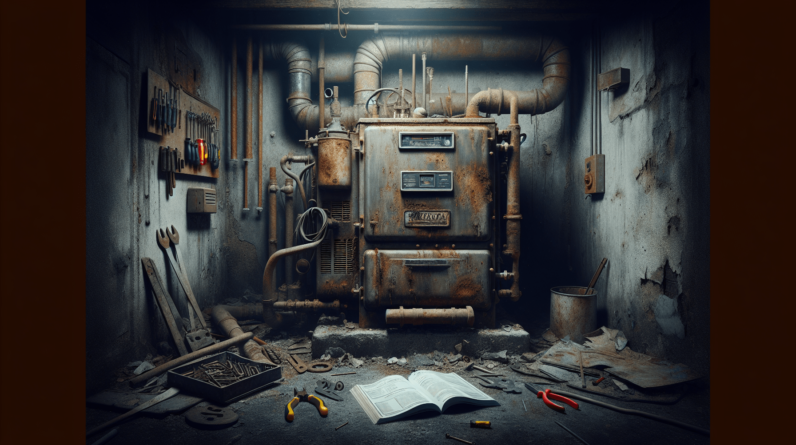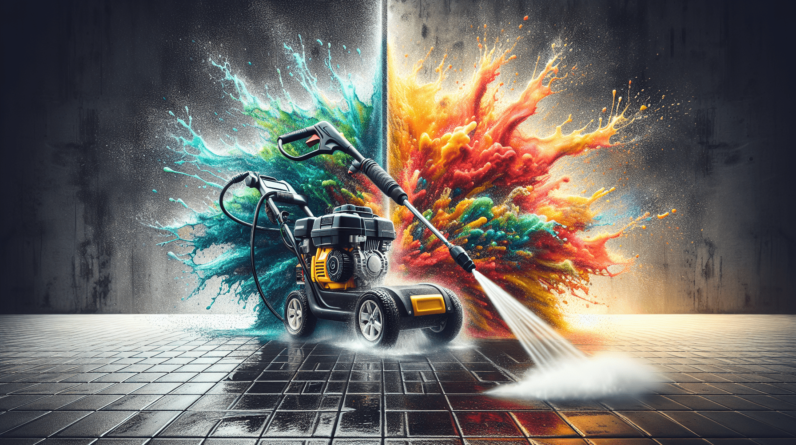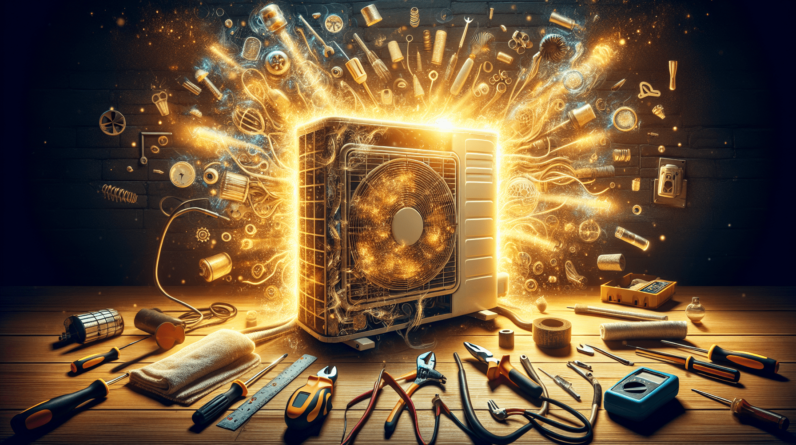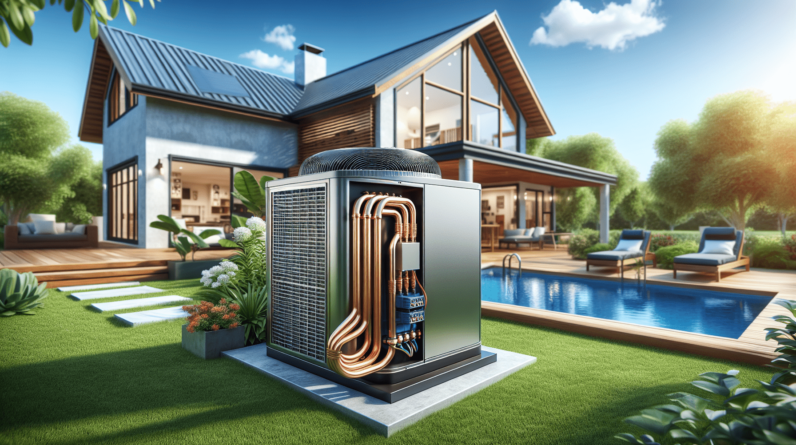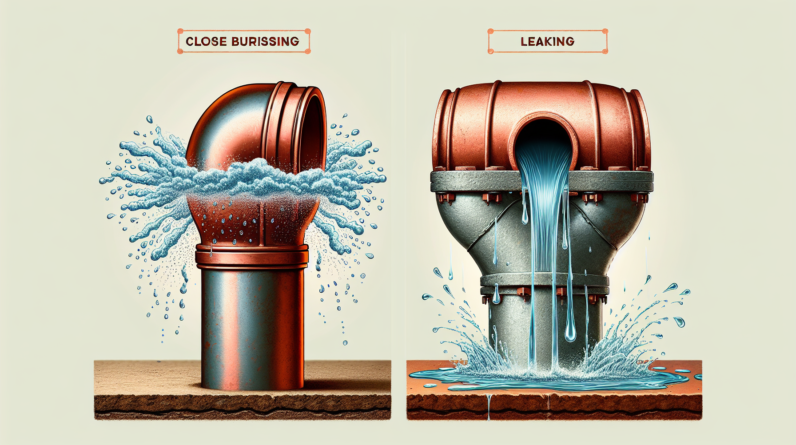

Imagine this scenario: you come into your home after a long day and find water spraying out of one of the pipes in your kitchen. Panic sets in as you scramble to find a solution. Is it a burst pipe or just a leak? Understanding the distinction between these two plumbing problems is crucial in determining the severity of the situation and how to address it. In this article, we will explore the key differences between burst pipes and leaking pipes, providing you with the knowledge to handle any plumbing emergency with confidence.
Definition of Burst Pipe
Explanation of burst pipe
A burst pipe refers to a pipe that has experienced a sudden, catastrophic failure, leading to the release of a substantial amount of water or other fluids. This type of pipe failure typically occurs due to excessive pressure or a significant structural weakness in the pipe material. When a pipe bursts, it can result in a sudden and forceful flow of water, causing significant damage to the surrounding area.
Causes of burst pipes
There are several reasons why pipes can burst. One common cause is freezing temperatures, especially in regions where the climate is colder. When water freezes inside a pipe, it expands, putting immense pressure on the pipe walls and potentially causing them to rupture. Other causes of burst pipes include corrosion, aging, physical damage such as accidental impact, and in some cases, excessive water pressure within the plumbing system.
Signs of a burst pipe
Recognizing the signs of a burst pipe is crucial to preventing extensive damage. Some common indicators include a sudden decrease in water pressure, noticeable water stains or wet spots on walls or ceilings, unusual sounds like dripping or hissing, and an unexplained increase in your water bill. If you notice any of these signs, it is essential to take immediate action to minimize the potential damage.
Potential damages caused by burst pipes
The damage caused by a burst pipe can be considerable. The forceful flow of water can quickly saturate walls, floors, and belongings, leading to significant structural damage, mold growth, and degradation of building materials. If left unattended, it can also result in electrical hazards, since water and electricity are a dangerous combination. Additionally, the excessive water waste from burst pipes can strain water resources and contribute to higher utility bills.
Actions to take when dealing with a burst pipe
When faced with a burst pipe, it is crucial to act swiftly and effectively to mitigate the damage. The first step is to locate the main water supply shut-off valve and turn it off to stop the flow of water. This will help prevent further water damage and give you time to assess the situation. Next, contact a professional plumber to evaluate and repair the burst pipe. While waiting for the plumber’s arrival, you can start removing water and drying out any affected areas to prevent mold growth and minimize water damage to your property.
Definition of Leaking Pipe
Explanation of leaking pipe
A leaking pipe is characterized by a slow and gradual release of water or other fluids from the pipe. Unlike a burst pipe, a leaking pipe does not experience a sudden and catastrophic failure. Instead, it often involves small cracks, loose fittings, or deteriorated seals that allow water to escape continuously. Though the flow of water may be slower compared to a burst pipe, leaking pipes can still lead to significant damage if not addressed promptly.
Causes of leaking pipes
Leaking pipes can result from various factors. One primary cause is corrosion, especially in older plumbing systems with pipes made of materials susceptible to degradation over time. Inadequate installation, improper maintenance, constant water pressure, excessive wear and tear, and even clogs can also contribute to the development of leaks in pipes. It is crucial to address even minor leaks promptly as they have the potential to worsen over time and cause more significant problems.
Signs of a leaking pipe
Detecting signs of a leaking pipe can help you address the issue early on. Common indicators include damp or discolored patches on walls, floors, or ceilings, the presence of mold or mildew, musty odors, low water pressure, and the sound of dripping water. If you observe any of these signs, it is essential to investigate further and take appropriate action to prevent further damage and potential health hazards associated with mold growth.
Potential damages caused by leaking pipes
While the immediate impact of a leaking pipe may not be as severe as a burst pipe, it can still result in significant damage over time. Water dripping or flowing continuously from a leak can lead to structural issues, such as weakened foundations, rotting of wood structures, and deterioration of building materials. Additionally, the persistent moisture from a leaking pipe creates an ideal environment for mold and mildew growth, posing health risks to occupants and potentially requiring costly remediation efforts.
Actions to take when dealing with a leaking pipe
When faced with a leaking pipe, it is important to take swift action to prevent further damage. Start by shutting off the water supply to the affected area or the entire property if necessary. This will help minimize the amount of water escaping and prevent it from causing further damage. Next, evaluate the severity of the leak and consider contacting a professional plumber to assess and repair the pipe. In the meantime, make sure to contain the leaking water using buckets or towels and begin drying out any affected areas to prevent water damage and inhibit mold growth.
Comparison
Characteristics of burst pipes
Burst pipes are characterized by sudden and catastrophic failures that result in a forceful release of a large volume of water. They often occur due to freezing temperatures, excessive pressure, or significant structural weaknesses in the pipes. Burst pipes can cause significant and immediate damage to the surrounding area, including structural damage, mold growth, and electrical hazards. Common areas of occurrence for burst pipes include colder climates and areas with aging or poorly maintained plumbing systems.
Characteristics of leaking pipes
Leaking pipes, on the other hand, involve a slower and continuous release of water or other fluids from small cracks, loose fittings, or deteriorated seals. They are commonly caused by corrosion, inadequate installation, improper maintenance, and wear and tear. While the flow of water from a leaking pipe may be slower compared to a burst pipe, it can still result in significant damage over time. Leaking pipes often lead to mold growth, structural issues, and the need for costly remediation efforts.
Differences in severity
One of the key differences between burst and leaking pipes lies in their severity. Burst pipes cause immediate and often more severe damage due to the sudden release of a large volume of water. The forceful flow can lead to widespread damage and pose immediate risks. On the other hand, leaking pipes may not cause immediate and noticeable damage, but they can still result in significant long-term issues if left unaddressed. The severity of the damage caused by leaking pipes tends to intensify over time as the leak worsens or goes unnoticed.
Extent of water flow
Another difference between burst and leaking pipes is the extent of water flow. Burst pipes release water forcefully and in large quantities, resulting in rapid flooding and potential property damage. In contrast, leaking pipes may only have a slow and steady drip or a small trickle of water. While the flow is generally less intense, it can still accumulate over time, leading to water damage and other issues if not addressed promptly.
Common areas of occurrence
Burst and leaking pipes can occur in various areas of a property, but they tend to have some common areas of occurrence. Burst pipes are more common in regions with colder climates, where pipes are more susceptible to freezing and subsequent bursting. They can also occur in areas where there is excessive water pressure or in older plumbing systems with weakened pipes. Leaking pipes, on the other hand, can occur anywhere within the plumbing system, but are often found in older pipes due to corrosion or in poorly maintained systems where wear and tear are prevalent.

Prevention and Maintenance
Preventing burst pipes
Preventing burst pipes begins with insulating exposed pipes in colder climates to protect them from freezing temperatures. This can be done using pipe insulation sleeves or heat tape. It is also important to maintain a moderate temperature inside the property, especially during freezing weather, to prevent pipes from freezing. Additionally, it is advisable to disconnect outdoor hoses before winter to prevent water from freezing and damaging the connected pipes. Regularly inspecting the plumbing system for signs of wear, corrosion, or excessive pressure can also help identify potential risks and proactively address them.
Maintaining pipe integrity
To maintain pipe integrity and prevent leaking pipes, it is essential to follow good plumbing practices. This includes ensuring proper installation and sealing of pipes, as well as utilizing high-quality materials. Regularly inspecting visible pipes for any signs of leaks, corrosion, or damage can help identify potential issues early on. Implementing a proactive maintenance routine, such as clearing clogged drains and pipes, reducing water pressure if necessary, and promptly addressing any plumbing issues can significantly contribute to maintaining pipe integrity and preventing leaks.
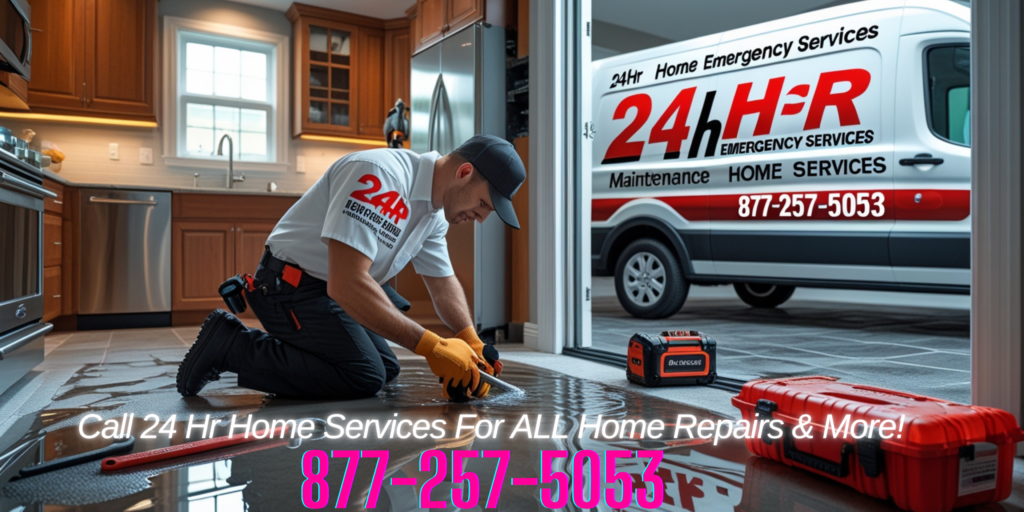
Preventing leaking pipes
Preventing leaking pipes involves similar practices to maintaining pipe integrity. A proactive approach, such as regular inspections, can help identify minor leaks before they worsen. Ensuring proper installation and using quality seals and fittings during plumbing projects can also help prevent leaks. In addition, avoiding harsh chemical drain cleaners and opting for more environmentally friendly alternatives can reduce the risk of pipes corroding or deteriorating. Taking care not to overtighten or strain pipes during installation or maintenance can also minimize the likelihood of leaks occurring.
Identifying and addressing pipe issues
To address pipe issues effectively, it is crucial to have a keen eye for identifying potential problems early on. Regularly inspecting visible pipes and checking for signs of leaks, dampness, or corrosion is key to detecting issues before they escalate. Any unusual sounds, odors, or changes in water pressure should also be investigated promptly. When issues are identified, it is best to consult a professional plumber for a thorough evaluation and appropriate repairs. Attempting to fix complex pipe issues without the necessary expertise can lead to further damage or exacerbate the problem.
Importance of regular inspections
Regular inspections of the plumbing system are essential for preventing and addressing pipe issues. By inspecting pipes, seals, fittings, and other components periodically, potential problems can be identified early on and preventative measures can be taken. Regular inspections may involve checking visible pipes in basements, crawl spaces, and utility rooms, as well as examining fixtures, faucets, and connections. Homeowners can also benefit from scheduling professional plumbing inspections to ensure a comprehensive evaluation of their entire plumbing system.
Repair and Restoration
Emergency repair for burst pipes
When faced with a burst pipe, immediate action is necessary to prevent further damage. Shutting off the main water supply is the first step in emergency repairs to stop the flow of water. Then, contact a professional plumber who specializes in emergency repairs, as they have the expertise and tools to handle the situation safely and effectively. While awaiting professional assistance, it is essential to remove standing water, dry out affected areas, and take measures to prevent mold growth. It is also advisable to document the damage for insurance purposes.
Professional assistance for burst pipes
Burst pipes often require the expertise of professional plumbers due to their complex nature and potential hazards. Professional plumbers can assess the extent of the damage, locate the source of the rupture, and recommend the most appropriate repair method. They have the necessary tools and equipment to address burst pipes effectively and minimize further damage. Additionally, professional plumbers can provide guidance on preventive measures, such as insulating exposed pipes or adjusting water pressure, to help prevent future occurrences.
Repair methods for leaking pipes
Repairing leaking pipes can vary depending on the severity and location of the leak. Minor leaks can often be fixed using pipe repair tape or epoxy putty, which provide a temporary solution until professional repairs can be carried out. For more significant leaks, such as those caused by corroded or damaged pipes, it is advisable to seek professional assistance. Professional plumbers can employ various repair methods, including pipe replacement, joint sealing, or re-soldering, depending on the specific situation and the type of plumbing system in place.
Handling minor leaks
If you encounter a minor leak, addressing it promptly can help prevent further damage. Start by shutting off the water supply to the affected area and assessing the severity of the leak. For small cracks or small leaks in fittings, pipe repair tape or epoxy putty can provide a temporary fix until professional repairs can be scheduled. It is important to monitor the repaired area closely and consider seeking professional assistance to address the underlying cause of the leak and prevent future occurrences.
Restoring affected areas
After a burst or leaking pipe incident, restoring the affected areas is a crucial step in minimizing the overall impact. Once the plumbing issue has been resolved and all necessary repairs have been carried out, it is essential to dry out any saturated materials, such as carpets, drywalls, or furniture, to prevent mold growth and further damage. Disinfecting the affected areas with appropriate cleaners or antimicrobial treatments can help remove potential contaminants. Depending on the extent of the damage, restoration may involve painting, replacing damaged materials, or seeking professional assistance for more complex repairs.
Cost Factors
Costs associated with burst pipes
Burst pipes can result in significant financial expenses. The costs associated with burst pipes involve various factors, including the extent of the damage, the location of the burst, and the required repairs. Emergency repairs done outside of regular working hours may also incur additional charges. The need for water damage restoration, structural repairs, and mold remediation further influences the final costs. Additionally, water wastage resulting from burst pipes can lead to higher utility bills, adding to the overall expenses.
Factors influencing repair costs for burst pipes
The repair costs for burst pipes can be influenced by several factors. The accessibility and location of the burst pipe may affect the complexity of the repair process and, consequently, the associated costs. The type and size of the affected pipe, as well as the materials required for repair, can also impact the overall expenses. Additionally, the urgency and need for emergency repairs may result in higher costs. Prioritizing timely repairs and working with professional plumbers can help minimize the overall repair costs associated with burst pipes.
Costs relating to leaking pipes
The costs associated with leaking pipes depend on various factors, including the severity and location of the leak, as well as the necessary repairs. Minor leaks may require simple fixes, such as applying pipe repair tape or epoxy putty, which are relatively inexpensive. However, more significant leaks that require professional assistance and extensive repairs can significantly increase the costs. Additionally, if the leak has caused damage to other areas, such as walls or floors, the expenses may further escalate.
Factors affecting repair costs for leaking pipes
Several factors can influence the repair costs for leaking pipes. The severity and location of the leak play a significant role in determining the complexity of the repairs and subsequently affect the costs. The materials and equipment needed for repairs, as well as any necessary pipe replacement, contribute to the overall expenses. Additionally, the labor costs associated with engaging professional plumbers for more complex or time-consuming repairs can influence the final costs. It is advisable to obtain multiple quotes and compare them to ensure a fair and reasonable price for the necessary repairs.
Insurance coverage for pipe issues
Insurance coverage for pipe issues varies depending on the type of insurance policy and the specific circumstances. Homeowner’s insurance typically covers burst pipes and resulting water damage, such as structural repairs and restoration costs. However, it is important to review the policy details to understand the coverage limits and any exclusions that may apply. Leaking pipes may or may not be covered, depending on the insurance policy and the cause of the leak. It is advisable to consult with the insurance provider to determine the extent of coverage and any necessary documentation for filing a claim.
Impact on Property
Property damage caused by burst pipes
Burst pipes can lead to significant property damage. The forceful flow of water can saturate walls, floors, and belongings, causing structural damage and compromising the integrity of building materials. Moisture from burst pipes creates an ideal environment for mold and mildew growth, which can further damage surfaces and pose health risks. In severe cases, burst pipes can result in flooding, leading to the destruction of furniture, appliances, and personal belongings. Timely action and comprehensive repairs are essential to mitigate the impact on the property.
Mold and mildew growth
One of the potential consequences of burst or leaking pipes is the growth of mold and mildew. The excessive moisture from water leaks promotes the proliferation of mold spores, which can lead to various health issues, including allergies, respiratory problems, and skin irritations. Mold growth can also cause further damage to building materials, compromising their structural integrity. It is crucial to address water leaks promptly, dry out affected areas, and engage in mold remediation efforts when necessary to prevent the spread of mold and the associated health risks.
Structural damage due to burst pipes
Burst pipes can result in significant structural damage to a property if not addressed promptly. The forceful flow of water can weaken foundations, erode wooden structures, and compromise the stability of walls and floors. Over time, this can lead to shifting foundations, sagging ceilings, and other structural issues that require extensive repairs. Additionally, the constant presence of water from burst pipes can corrode metal pipes or other structural components, exacerbating the damage and necessitating more substantial restoration efforts.
Property damage caused by leaking pipes
Although the immediate impact of a leaking pipe may not be as severe as a burst pipe, it can still cause noteworthy damage to a property. The continuous flow of water from a leaking pipe can saturate building materials, leading to the deterioration of walls, ceilings, and floors. If left unattended, leaking pipes can weaken structures, contribute to mold growth, and result in costly repairs. The damage caused by leaking pipes can be particularly extensive if the leak goes unnoticed for a significant period, allowing water to permeate various areas of the property.
Effects of water damage on property
Water damage can have long-lasting effects on a property if proper measures are not taken to address it promptly and effectively. Aside from the obvious physical damage, such as discolored walls, peeling paint, or warped floors, water damage can also impact the functionality of a property. Electrical systems may be compromised, posing safety hazards, and appliances or furniture can be irreparably damaged. Additionally, the presence of excessive moisture can create an ideal environment for mold and mildew growth, which can further deteriorate surfaces and compromise indoor air quality.
Environmental Implications
Water waste caused by burst pipes
Burst pipes contribute to significant water waste, which has both financial and environmental implications. The forceful flow of water from burst pipes results in the loss of a substantial amount of water, putting a strain on water resources. This excessive water waste affects the availability of water for other essential purposes and can contribute to higher utility bills for individuals and communities. In regions where water scarcity is a concern, preventing and promptly addressing burst pipes is crucial to conserve this valuable resource.
Environmental impact of burst pipes
The environmental impact of burst pipes extends beyond water waste. The flooding caused by burst pipes can result in soil erosion, potentially polluting nearby water bodies with sediment and other contaminants. Burst pipes can also lead to increased energy consumption, as the excessive use of pumps and other equipment may be required for water removal and restoration efforts. Additionally, the use of harmful chemicals for mold remediation or cleaning up after burst pipes can have negative implications for the environment. It is important to consider eco-friendly solutions when dealing with burst pipes to minimize their environmental impact.
Chemical pollution risks from leaking pipes
Leaking pipes pose a risk of chemical pollution if they carry corrosive or hazardous substances. For example, pipes in industrial settings or those that transport chemicals can develop leaks, potentially releasing harmful substances into the environment. This can contaminate soil, groundwater, air, or nearby bodies of water, affecting ecosystems and potentially endangering human health. Proper maintenance, regular inspections, and prompt repairs of leaking pipes are essential to prevent chemical pollution and mitigate the associated risks.
Water conservation efforts
Efficient water management and conservation efforts play a vital role in preventing pipe issues and reducing environmental impact. Conserving water through simple practices, such as fixing leaky faucets, using water-saving fixtures, and practicing responsible water usage, can help reduce the strain on water resources. Additionally, raising awareness about the importance of water conservation can encourage individuals and communities to implement sustainable habits and minimize excessive water consumption.
Eco-friendly solutions
When faced with pipe issues, opting for eco-friendly solutions can help minimize the environmental impact. Choosing plumbing materials with lower environmental footprints, such as environmentally friendly sealants or PVC-free pipes, can support sustainability efforts. Applying green cleaning methods during restoration and mold remediation can reduce chemical pollution risks. Embracing renewable energy sources for water heating or installing water-efficient appliances can also contribute to overall environmental sustainability. By considering eco-friendly solutions, individuals and communities can address pipe issues while minimizing their ecological footprint.
Common Misconceptions
Common misconceptions about burst pipes
Misconception 1: Burst pipes only happen in cold climates.
Reality: While freezing temperatures do increase the risk of burst pipes, they can occur in any climate where there are factors like excessive pressure or structural weaknesses. Burst pipes can happen in warm climates as well.
Misconception 2: Burst pipes are always caused by extreme water pressure.
Reality: While excessive water pressure can contribute to burst pipes, other factors such as freezing, aging pipes, or physical damage can cause a pipe to burst. It is essential to address these issues to prevent future bursts.
Misconception 3: Burst pipes can be easily fixed using temporary solutions.
Reality: Burst pipes require professional assistance and a comprehensive repair approach. Temporary fixes may provide temporary relief, but they do not address the underlying issues that caused the burst in the first place.
Debunking myths about leaking pipes
Myth 1: Small leaks are not a cause for concern.
Reality: Even minor leaks can indicate underlying issues that, if left unaddressed, can worsen over time. Ignoring small leaks can lead to more significant damage and costly repairs in the future.
Myth 2: Leaking pipes will fix themselves over time.
Reality: Leaking pipes will not fix themselves. In fact, without prompt repairs, leaking pipes can worsen, leading to more significant issues such as mold growth, structural damage, and increased water wastage.
Myth 3: DIY repairs are sufficient for fixing leaking pipes.
Reality: While minor leaks may be temporarily fixed using DIY methods, professional assistance is crucial for assessing the extent of the damage and implementing effective repairs. DIY repairs may not address the underlying cause of the leak, resulting in recurring issues.
Misunderstandings regarding pipe issues
Misunderstanding 1: Pipe issues only occur in older homes.
Reality: Pipe issues can occur in properties of any age. Aging pipes may be more susceptible to corrosion, but even newer homes can experience pipe failures due to factors like freezing temperatures, improper installation, or physical damage.
Misunderstanding 2: Pipe issues are always visible.
Reality: Not all pipe issues are immediately visible. Leaks can occur behind walls or underground, going unnoticed until significant damage has already occurred. Regular inspections and vigilant monitoring of water usage can help identify hidden pipe issues.
Misunderstanding 3: Pipe issues are only the responsibility of the homeowner.
Reality: While homeowners have a duty to maintain their plumbing systems, certain pipe issues may be the responsibility of the utility company or rental property owner. Understanding who is responsible for pipe repairs and maintenance is crucial for timely resolution.
Importance of accurate knowledge
Having accurate knowledge about burst and leaking pipes is essential for homeowners and property occupants. Understanding the differences between burst and leaking pipes, as well as their causes, signs, and potential damages, empowers individuals to take appropriate action and prevent further problems. Recognizing common misconceptions and debunking myths helps dispel incorrect beliefs, ensuring that the right steps are taken to address pipe issues effectively. With accurate knowledge, individuals can make informed decisions, engage professional assistance when necessary, and prioritize preventative measures to maintain the integrity of their plumbing systems.
Conclusion
Understanding the difference between burst pipes and leaking pipes is crucial for homeowners and property occupants. Burst pipes are characterized by sudden failures that release a large volume of water, causing immediate and severe damage. Leaking pipes, on the other hand, involve a slow and continuous release of water from minor cracks or loose fittings. While the immediate impact of leaking pipes may be less severe, their long-term implications can be significant if left unaddressed. Taking preventative measures, such as insulating exposed pipes and conducting regular inspections, can help prevent both burst and leaking pipes. Prompt action, such as shutting off the water supply and seeking professional assistance, is crucial when dealing with pipe issues. With accurate knowledge and appropriate actions, property owners can mitigate the damages, minimize repair costs, and ensure the long-term integrity of their plumbing systems.

